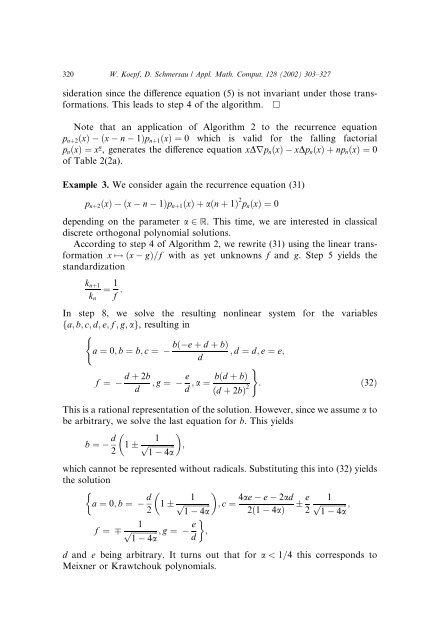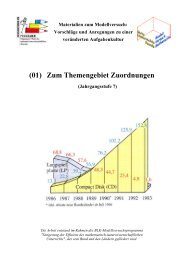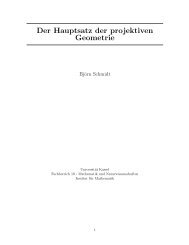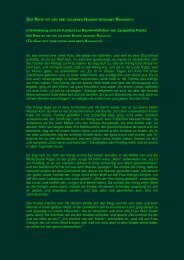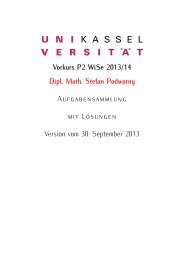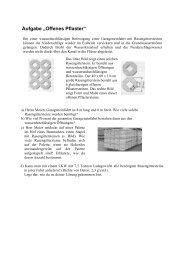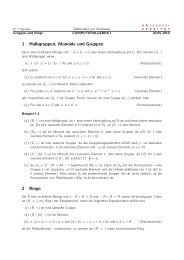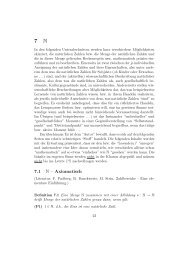Recurrence equations and their classical orthogonal polynomial ...
Recurrence equations and their classical orthogonal polynomial ...
Recurrence equations and their classical orthogonal polynomial ...
Create successful ePaper yourself
Turn your PDF publications into a flip-book with our unique Google optimized e-Paper software.
320 W. Koepf, D. Schmersau / Appl. Math. Comput. 128 (2002) 303–327<br />
sideration since the difference equation (5) is not invariant under those transformations.<br />
This leads to step 4 of the algorithm.<br />
Note that an application of Algorithm 2 to the recurrence equation<br />
pnþ2ðxÞ ðx n 1Þpnþ1ðxÞ ¼0 which is valid for the falling factorial<br />
pnðxÞ ¼x n , generates the difference equation xDrpnðxÞ xDpnðxÞþnpnðxÞ ¼0<br />
of Table 2(2a).<br />
Example 3. We consider again the recurrence equation (31)<br />
pnþ2ðxÞ ðx n 1Þpnþ1ðxÞþaðn þ 1Þ 2 pnðxÞ ¼0<br />
depending on the parameter a 2 R. This time, we are interested in <strong>classical</strong><br />
discrete <strong>orthogonal</strong> <strong>polynomial</strong> solutions.<br />
According to step 4 of Algorithm 2, we rewrite (31) using the linear transformation<br />
x 7! ðx gÞ=f with as yet unknowns f <strong>and</strong> g. Step 5 yields the<br />
st<strong>and</strong>ardization<br />
knþ1<br />
¼<br />
kn<br />
1<br />
f :<br />
In step 8, we solve the resulting nonlinear system for the variables<br />
fa; b; c; d; e; f ; g; ag, resulting in<br />
(<br />
a ¼ 0; b ¼ b; c ¼<br />
f ¼<br />
d þ 2b<br />
; g ¼<br />
d<br />
bð e þ d þ bÞ<br />
; d ¼ d; e ¼ e;<br />
d<br />
e bðd þ bÞ<br />
; a ¼<br />
d ðd þ 2bÞ 2<br />
)<br />
: ð32Þ<br />
This is a rational representation of the solution. However, since we assume a to<br />
be arbitrary, we solve the last equation for b. This yields<br />
b ¼ d<br />
2 1<br />
1<br />
p ffiffiffiffiffiffiffiffiffiffiffiffiffi ;<br />
1 4a<br />
which cannot be represented without radicals. Substituting this into (32) yields<br />
the solution<br />
a ¼ 0; b ¼ d<br />
2 1<br />
1 4ae e 2ad e 1<br />
p ffiffiffiffiffiffiffiffiffiffiffiffiffi ; c ¼ p ffiffiffiffiffiffiffiffiffiffiffiffiffi ;<br />
1 4a 2ð1 4aÞ 2 1 4a<br />
1<br />
e<br />
f ¼ p ffiffiffiffiffiffiffiffiffiffiffiffiffi ; g ¼ ;<br />
1 4a d<br />
d <strong>and</strong> e being arbitrary. It turns out that for a < 1=4 this corresponds to<br />
Meixner or Krawtchouk <strong>polynomial</strong>s.


